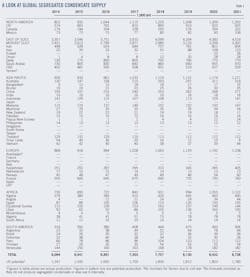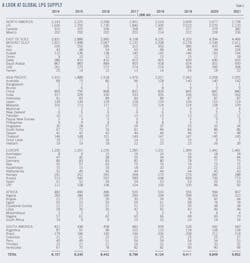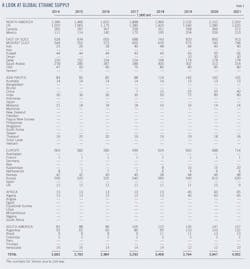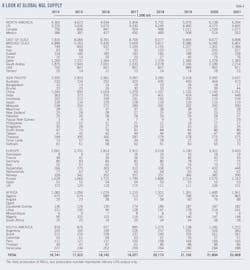Surge in NGL and tight-oil supplies creates worldwide 'light-ends space'
Al Troner
Asia Pacific Energy Consulting
Houston
While many analysts agree that oversupply, rather than weak demand, led to the current slump in the price of crude oil, few have looked closely at the nature of that supply overhang.
In a new study, Asia Pacific Energy Consulting (APEC) has examined in depth the role of NGLs, in particular condensate, in creating the current surplus, as well as the impact of tight oil and its light derivatives.1 The condensate, other NGLs (LPG and ethane), light products, and tight oil yielding much of the new light-product supply all occupy the same light segment of the hydrocarbon spectrum.
The shale revolution has spurred a ballooning of NGL output, paralleled by dizzying growth in tight oil production. Almost all of this incremental liquids production has been light and sweet. The growing volume of this material, with incremental supply in the millions of barrels per day, has begun to shift pricing, trade, marketing, and supply-demand balances for crude-light-heavy vs. sweet-sour-and in products, with notable supply gains in LPG, gasoline, and naphtha in contrast to middle-barrel and heavy products.
A "light-ends space" is emerging, not only in the US and the Atlantic Basin but also globally, as markets attempt to adjust to this surge in light, low-sulfur hydrocarbon supply.
Focus on condensate
The APEC study focused on the role of condensate as the spearhead creating this light-ends space because it is the only NGL that does not need specialized containment and that, when refined, yields a full range of products, from LPG to residual. Once condensate becomes a liquid it remains a liquid, and in a refinery or condensate splitter acts much like crude in the slate.
Condensate is often confused with light, sweet crude oil, yet it has distinctive characteristics. Unlike crude, condensate always originates with gas, whether nonassociated or associated. Whole condensate almost always yields more than 50% naphtha and is almost always quite clean, low not only in sulfur but also in metals and acid.
It is exceptionally clear, with most containing 0.3% sulfur or less.
Many observers try to define condensate by setting an arbitrary API gravity breakpoint: in the US commonly 45° API, in international trade usually 50° API. But these are rules made to be broken. There are crude grades well above 50° API, such as Saudi Arabia's Super Light and Australia's Laminaria. There are condensate grades under 50° API, such as Kazakhstan's Karachaganak and Nigerian Oso. In defining what constitutes condensate, API gravity is only a general indicator, not an exact test of what is condensate and what is crude.
What is important for condensate is that it always originates in gas, almost always yields 50%+ naphtha, is exceptionally sweet, contains little if any metals, and produces little residual oil. A crude and condensate can have exactly the same API gravity, but the condensate will always yield far more naphtha and far less fuel oil.
The US has emerged as a major NGL power due to the shale revolution. Despite the plateau and then decline of tight oil production in 2016, overall NGL output will continue to rise despite declining condensate volumes produced with tight oil, according to the US Energy Information Administration.
In part this is due to the nature of NGLs, caught in a twilight zone of production parameters. NGLs come from both the crude and the gas sides of total production. And while condensate has been the most prominent NGL derived from gas produced in association with tight oil, plays such as the Eagle Ford shale and Permian basins also have produced sizable volumes of LPG and even commercial volumes of ethane. Yet NGLs also come from primarily nonassociated gas production as well, such as the Marcellus and Utica shales in the US Northeast.
Tight oil production, concentrated in the Bakken, Eagle Ford, and Permian plays, has accounted for much of the US increase in oil production and, together with the Marcellus-Utica developments, condensate output in recent years. All have experienced differing production profiles for condensate in 2016. Overall Eagle Ford production, including condensate, declined sharply by early 2016 and was trending lower toward midyear. Permian crude and condensate production continued to rise, albeit at a diminishing rate, into the year's second quarter. And while Bakken crude output fell sharply, condensate production rose as producers moved to curb gas flaring and strip gas output for NGL flows.
Nationally, propane and butane production continued to rise, mainly on field output, while ethane output used for petrochemicals recorded small volume gains.
US product exports
Almost unheralded, the US has emerged as the largest exporter of oil products, based on Gulf Coast refiners' use of relatively inexpensive, domestically produced tight oil. The product-export flood has been paralleled by large-volume NGL sales, with LPG leading the way, in particular propane.
US sales have not only saturated the Atlantic Basin market but also become important to Asia Pacific supply. At mid-2015 China was the biggest single customer for US propane. And the opening of a revamped and enlarged Panama Canal by yearend will likely increase westbound LPG exports from the Gulf Coast even further. By 2018 US exports of LPG exports will likely equal or exceed those of the United Arab Emirates and Qatar combined.
Canada remains the top condensate US export market. APEC expects US supply to dominate Canadian diluent use until at least end-decade. Yet domestic condensate output has been growing rapidly in Canada, based on tight oil and shale gas development, in a trend APEC expects will gradually back out US sales in the coming decade. A steadier though smaller market emerged for slightly refined condensate in Europe, where refiners use the material regularly to fill out crude slates. By 2018 US condensate exports will exceed overseas sales by Saudi Arabia, and possibly by the kingdom and Qatar combined.
Ethane exports have begun as US sellers pioneered waterborne ethane shipments to buyers in the UK, Norway (Ineos and Sabic), and Sweden (Borealis). This has been followed by sales to India (Reliance) and China (Orient Energy).
The emergence of the light-ends space has not been solely a western market phenomenon. It has had East of Suez impacts as well, much of it centered on the Persian Gulf.
East of Suez
Iran and the US have emerged as the two main drivers of condensate supply through the medium term, and both could be exporting substantially increased volumes by 2018 (Table 1).
The Islamic Republic has long been a major condensate exporter, but progressively tightening sanctions cut deeply into Iranian sales abroad while a lack of project investment slowed the long-anticipated expansion of South Pars field condensate and LPG output.
Iran's condensate prospects hinge on the speedy removal of economic sanctions and a fast-track program to complete long-delayed gas developments. Immediate impacts of easing sanctions included the disposal of 20-30 million bbl of condensate in floating storage. South Korea and Singapore emerged as major buyers, supplementing China and India, while Japan took experimental cargoes, being cautious about the quality of condensate that had sat in storage for months.
Yet overall so far, Iran has made only limited progress in reversing years of sector neglect. In the first half of 2016 Iran added about 350,000 b/d of liquids production. Of that, only about 35,000 b/d was condensate, although the latter rate should more than double with the start-up of a South Pars phase in the third quarter. By end-2016 APEC expects Iranian production to rise by roughly 500,000 b/d over the previous year's level, with nearly 100,000 b/d of that condensate.
Qatar has the most to lose from a freeing of Iranian marketing. The tiny emirate had a lock-hold over Asian markets that needed large condensate volumes and could not import the material from Iran. This will add considerable pressure on Qatar International Petroleum Marketing Co. (Tasweeq) to reshape its condensate marketing program. Only these two producers are capable of selling condensate in large amounts in the East of Suez market. Unlike Iran, Qatar does not have black oil as a back-up export.
Investment in Iran
Foreign companies are moving cautiously on Iranian investment, upstream and downstream, with legal guidelines and financing regulations still unclear. National Iranian Oil Co. (NIOC) and National Petrochemical Corp. (NPC) plan a massive expansion of Iranian condensate-processing capacity, using condensate splitters and petrochemical pretreatment units.
Official plans call for the completion of nine more condensate splitters, in the Persian Star and Siraf projects, with working capacity totaling 828,000 b/d. This is in addition to the 258,000 b/d of working capacity at six sites operating as of January this year. What's more important, the first part of a three-unit splitting complex, the long-delayed Persian Star, will be commissioned by the second half of 2016. While targeted start-up dates almost certainly are overly ambitious-Siraf is slated to add 480,000 b/d in eight 60,000-b/d units by 2019-it is clear that Iran's condensate processing capacity will soon exceed that of other Gulf producers combined and that the plants will produce enormous volumes of condensate outturn, mainly naphtha.
However, the intent in using this expanded splitter capacity is very different from the ongoing US splitter campaign. Since 2015 the US, mainly on the Gulf Coast, has added five condensate splitters with capacity totaling 309,000 b/d, all aimed at export sales. NIOC has claimed that by end-decade, with the completion of currently planned condensate splitters, the country will have no condensate to export, despite a strong build-up in condensate production. Iran will produce over 800,000 b/d of condensate by 2021, yet Tehran's goal is to use all of this output-in particular the naphtha-gasoline outturn potential-for home-market needs.
Even if this goal of diverting condensate into domestic use succeeds only partially, there is little other new condensate output due to emerge through 2018 in East of Suez markets. In the short term, the direction and volume of US exports will be shaped by the price differential between Brent and West Texas Intermediate crudes as well as the opening of an expanded Panama Canal.
Structural change
In Asia Pacific, only Australia will contribute significantly to incremental condensate output. Multiple projects will add segregated condensate output-but only toward end-decade. Of particular significance is Ichthys, which will likely equal, if not exceed, output from the Northwest Shelf.
The APEC study sees, as a pivotal structural change, the emergence of a "Yin-Yang" of a US light hydrocarbons long position, underpinned by massive NGL output moving to Asia Pacific, complemented by Asia's desire to limit its dependence on Mideast crude, refinery products, and NGLs.
APEC expects US condensate exports to Asia Pacific to grow rapidly once sellers adjust their condensate blends to Asian petrochemical needs. This will represent strong competition to both Iran and Qatar, with US export rates on the order of 200,000 b/d. Asian buyers will soon have a wide range of suppliers possibly discounting to retain market share. Of course US exports of other NGLs, light products, and even tight oil will increase total sales (Tables 2-4).
Dominating Asian condensate demand will be South Korea, which will continue to increase its lead as the region's top condensate processor. The start-up of additional splitters will have the country capable of processing over 700,000 b/d of condensate through splitters as well as running condensate in conventional refineries. South Korea overtook Beijing as the top Asian condensate user by 2013 and has made cross-integration of condensate processing and petrochemicals a major plank of export sales.
China remains a market paradox. Expansion plans for condensate splitting have been suspended as the central government reevaluates all new downstream projects. The shutdown of Dragon Aromatics has actually reduced splitting capacity in this market, though it is likely that Sinopec will take over the now-shuttered complex and operate the splitter with side-by-side petrochemical aromatics units by 2017.
Singapore and India have emerged as major condensate import markets, both for splitting but more importantly for crude blending. India is strategically placed for short-haul sales from the Persian Gulf and is expected to sharply increase its Iranian imports in the medium term.
Japan has remained a major condensate user, but volumes have been static in recent years-a reflection of the essentially stagnant Japanese market. Together with much smaller Thailand, these markets remain important but not key for new condensate sales.
The big picture remains the same. The emergence of the light-ends space has been paralleled in Asia by a shift in demand focus from middle distillates to lighter products. US NGLs have already made considerable inroads into Asian markets and ultimately will present a long-term marketing challenge to Mideast exporters: Who gains the future demand growth of Asia Pacific?
Reference
1. The full study, East Meets West, can be purchased from PennEnergy at http://ogjresearch.stores.yahoo.net/condensate-east-meets-west.html.
The author
Al Troner is president of Asia Pacific Energy Consulting. He has worked in Asia's energy sector since 1984, when he established Dow Jones/Telerate's regional energy services. He moved to Singapore in 1989 to found and then direct Petroleum Intelligence Weekly's Asia-Pacific bureau. He was the cowinner of the International Association for Energy Economics award for Energy Journalism in 1994, retiring from journalism the following year to found APEC.
During 1987-89, he was a research assistant for the energy group of the East-West Center. Troner has worked in the energy industry in the US, Europe, North Africa, and Middle East, as well as in Asia Pacific.



